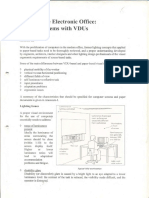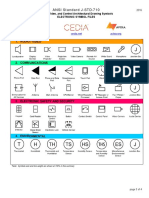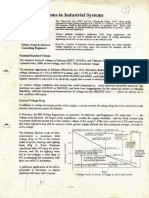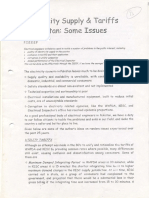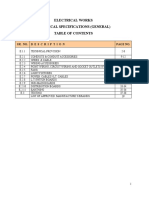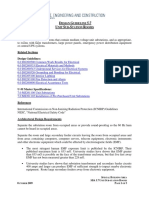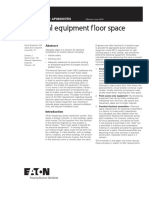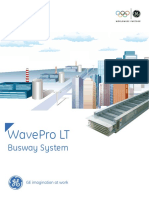Earth Leakage Protection
Earth Leakage Protection
Uploaded by
naveedfnd0 ratings0% found this document useful (0 votes)
49 views6 pagestechnical paper on electrical safety
Copyright
© © All Rights Reserved
Available Formats
PDF or read online from Scribd
Share this document
Did you find this document useful?
Is this content inappropriate?
Report this Documenttechnical paper on electrical safety
Copyright:
© All Rights Reserved
Available Formats
Download as PDF or read online from Scribd
Download as pdf
0 ratings0% found this document useful (0 votes)
49 views6 pagesEarth Leakage Protection
Earth Leakage Protection
Uploaded by
naveedfndtechnical paper on electrical safety
Copyright:
© All Rights Reserved
Available Formats
Download as PDF or read online from Scribd
Download as pdf
You are on page 1of 6
Earth Leakage Protection:
Safety from Fire
& Shock Hazards
Roland deSouza, F.ILE.E.E.P
. Naveed Jabbar, AMLE.E.EP
In an earlier paper entitled “ Earthing for Safety of Personnel” presented at the 1991 IEEEP
Multi-Topic Symposium in Karachi, one of the authors had discussed the various systems of
earthing (TNS, TNCS, TT, IT) detailed in the IEE/UK “Wiring Regulations”, the shock
hazards due to “indirect” and “direct” contact with electricity, and the concept of “earth-loop
impedance”.
This presentation addresses the principles and use of earth-leakage circuit breakers, and their
application to protection of personnel against shock and fire hazards. A number of previous
Papers on the subject have been read in electrical engineering forums (see References), but
these efforts have still not brought about the widespread use of CDs in domestic,
commercial and industrial installations in Pakistan.
A proper awareness of the ensuring benefits and strict applications of codes and regulations
has resulted in common employment of earth-leakage protective devices in the developed
nations of North America and Europe, the “Tigers” of South Asia, and even countries like Sir
Lanka and India,
Available figures indicate that presently about 6000 RCDs are sold in Pakistan annually, with
85% being used in the north of the country. This may be due to the higher pre-ponderance of
self-constructed single-unit residences among the educated middle and upper classes as
compared to the great majority of developer-built multi-unit residences in Karachi.
Danger of Electricity
There are many popular misconceptions and old wives tales, even among engineers, about
the effects of electricity and the role of conventional protection devices (circuit-breakers and
fuses) in providing protection against these problems.
First, it must be realised that the most common type of electrical fault is not a phase-to-phase
short-circuit, or a phase-to-neutral short-circuit, but a phase-to-earth fault, Many of these are
high-impedance or arcing fault, and thus have a very limited fault current,
Second, more people are killed in fires attributed to electrical equipment and wiring than are
killed as a result of electric shock. Some official figures for the United Kingdom indicate that
between four and six times as many people die in fires caused by electrical installations as
from electrocution.
Kite: With most fires of electrical origin, earth-leakage currents of less than 1 amp (ie.
"power less than 230W) can start a conflagration. Thus conventional mcbs & fuses, with
rating of 6A or 10A or 16A cannot in most cases protect against earth-leakage currents, and
consequently agaiit fires.
Shock: With an
average human
TUR Seon body resistance of
' 2 teste | around 1000 ohms,
| ros 2 the carth-leakage
+ Mawmowe | shock current
5 Steesctea | flowing would be
aso 9) 0.23 amps. This
ety
sop figure is well
pie below the trip
518% e010 00 STG ax two kos ratings of common
Z ee MCBs and fuses:
thus they could not
Fig 1 Time Current Zones of Effect on Persons Protect sgzinst
“direct contact”
shocks, as the human body is adversely affected by currents in excess of 30mA. Fig 1 is
based on IEC 479 and shows the effects of current and time on humans,
Principles of Operation
RCDs monitor the balance between
the load current and return current, | Tot mt t it
As shown in Figure 2 when an| sn $f geen ie ah] een
carth leakage current is present, I, a
& Iyare not equal and opposite and| 1, es
the resultant magnetic flux in sap ae ae
toroid/ current balance transformer | covet re cet ed
induces a voltage in the fault] smi ets
sensing winding. This voltage
signal isolates the circuit through a cow eG
remote or built-in tripping device.
Fig 2 Principle of Operation
Pakistan Electricity Regulations
Clause 25 of the Electricity Regulations 1937 states that :
"A licensee shall not connect with his works the apparatus onthe premises of any applicant for a supply
unless he is reasonably satisfied thatthe connection will not atthe time of making the connection cause t
leakage from that apparatus exceeding one five-thousandth part ofthe maximum supply demanded on the
applicant's premises
‘Thus a domestic consumer in Pakistan with a 2 kW (10 amp) supply from WAPDA/KESC
could not have a leakage current in excess of 2 mA without his supply being legally
disconnected. This value is unrealistic, For instance, British and European standards
covering safety generally include limiting values of leakage current for various common
appliances, as shown in Fig.2 . In a typical house, the total normal leakage would be in
excess of 2mA.
a a
BSMS6Chusel62 | TAS ash ‘S08 TBS EN ainsi
mA mA ma mA
0. os 7
07 10 o v |
0-75 arO7s per RW rae
inpuc or te appliance,
whichever the greater with
|s maximum of SA
w “as v T
Fig 3 Earth Leakage Limits
‘Types of earth-leakage protection devices
‘The standards governing earth-leakage protection devices are IEC 1008, EN 61008,
+ DIN VDE 0664.
IEC has now adopted the term RCD (Residual current devices) in place of earth leakage
detectors. Residual current devices currently available can be broadly classified into two
categories:
Relays: Devices that detect the earth leakage current and produce a signal for
isolation of a remote power circuit.
Cireuit Breakers: Devices that provide both detection and isolation of faulty circuit
against earth leakage, overload & short circuit.
‘These can be further sub-divided on the basis of installation details and additional features as
below:
RCDs
RELAYS CIRCUIT BREAKERS
Relays with built-in Relays with _Earth-leakage protection __Barth leakage
toroids (add-on blocks) separate oroids —gnly (RCCBs, ELCBs)_* Overload /SC protect
(RCBO's)
Ratings of RCDs:
‘Commonly available sizes of RCCB & ELCBs and RCBOs are
Poles Rating ‘Trips ‘Approx. Cost
Relays | without ingle & _fupto 200A [S0mA to 5A — |Rs. 14,000 -35,000
separate toroids free phase ladjustable
| Addon Blocks [2,34 lwith mcbs upto _[30.0r300mA Rs. 4,000 - 7,000
1008
[Circuit RCCBS ITord pale ]16,25,40,63,80,100,]10 30,100,300, [RS 2,500- 4,000
IBicakers | ELCBs 125,160,224 |500,1000mA
|. RCBOs lop 6,10,16,20,25,32,40|30 or 300mA Rs. 3,000 - 6,000
Sensitivities
‘The commonly available trip ratings and their fields of applications are given below
Trip Rating Fields of Applications
Toma Tsed in special applications where additional protection against contact is essential
due to the nature of the installation.
30mA “Tripping current designated by the IEE Wiring Regulations to provide additional
protection against direct contact shock i.e. socket outside the equipotential zone, TT
‘Systems, Carvan installation, etc.
ToOmA Tailable Tor use against indirect conlact shock or where protection is provided to
‘guard against fie hazard etc rather than to provide adsitional protection to personnel,
‘and where the earthing requirements need supplementing by RCD Protection.
y
— Pulsating d.c. components may be present (occasioned by rectifiers, choppers, phase-
angle control devices in common domestic, commercial and industrial appliances and
equipment) in earth-leakage current, and a standard RCD may not respond,
‘Thus special sensitivity to d.c components needs to be built in, and such RCDs are
marked [->CA]
Special Applications
Increased shock risks in particular situations generally warrant the use of additional measures
for protection. Wiring and safety regulations in developed countries mandate that
30mA RCDs are employed in situations involving
1) Wetness, e.g., water, humidity, perspiration
2) Absence of, or minimal, clothing, e.
swimming pools, saunas, working in hot weather.
3) Presence of earthed metal, e.g., restrictive conductive locations, tanks/shells/ vessels,
plant rooms.
4) Arduous conditions, e.g., construction sites, trailing cables.
Teiness | Absence of, or | Presence of | Arduous
minimal clothing} earthed metal | conditions|
ay Q 3 4)
swimming Pool
fot Air Saunas
Tonsinuction Sites
ricultural & Horticultural Premises
esiricuive Conductive Locations
aravans & Motor Caravans
ravan.
a applies & Street Furniture
Fig 6 Increased Shock Risk Applications
In Pakistan, very few swimming pools (i.c., electric pumps, underwater lights, nearby
lights/sockets) are fed though 30mA RCDs: this must change. Almost no building
construction sites have their temporary lighting and power distribution system fed through a
30mA RCD. Commercial and industrial kitchens need RCD protection to safeguard workers,
School/college and medical laboratories, electric work/test benches, portable tools (
You might also like
- The Subtle Art of Not Giving a F*ck: A Counterintuitive Approach to Living a Good LifeFrom EverandThe Subtle Art of Not Giving a F*ck: A Counterintuitive Approach to Living a Good LifeRating: 4 out of 5 stars4/5 (5867)
- The Gifts of Imperfection: Let Go of Who You Think You're Supposed to Be and Embrace Who You AreFrom EverandThe Gifts of Imperfection: Let Go of Who You Think You're Supposed to Be and Embrace Who You AreRating: 4 out of 5 stars4/5 (1094)
- Never Split the Difference: Negotiating As If Your Life Depended On ItFrom EverandNever Split the Difference: Negotiating As If Your Life Depended On ItRating: 4.5 out of 5 stars4.5/5 (866)
- Grit: The Power of Passion and PerseveranceFrom EverandGrit: The Power of Passion and PerseveranceRating: 4 out of 5 stars4/5 (597)
- Hidden Figures: The American Dream and the Untold Story of the Black Women Mathematicians Who Helped Win the Space RaceFrom EverandHidden Figures: The American Dream and the Untold Story of the Black Women Mathematicians Who Helped Win the Space RaceRating: 4 out of 5 stars4/5 (909)
- Shoe Dog: A Memoir by the Creator of NikeFrom EverandShoe Dog: A Memoir by the Creator of NikeRating: 4.5 out of 5 stars4.5/5 (543)
- The Hard Thing About Hard Things: Building a Business When There Are No Easy AnswersFrom EverandThe Hard Thing About Hard Things: Building a Business When There Are No Easy AnswersRating: 4.5 out of 5 stars4.5/5 (352)
- Elon Musk: Tesla, SpaceX, and the Quest for a Fantastic FutureFrom EverandElon Musk: Tesla, SpaceX, and the Quest for a Fantastic FutureRating: 4.5 out of 5 stars4.5/5 (474)
- Her Body and Other Parties: StoriesFrom EverandHer Body and Other Parties: StoriesRating: 4 out of 5 stars4/5 (824)
- The Emperor of All Maladies: A Biography of CancerFrom EverandThe Emperor of All Maladies: A Biography of CancerRating: 4.5 out of 5 stars4.5/5 (272)
- The Sympathizer: A Novel (Pulitzer Prize for Fiction)From EverandThe Sympathizer: A Novel (Pulitzer Prize for Fiction)Rating: 4.5 out of 5 stars4.5/5 (122)
- The Little Book of Hygge: Danish Secrets to Happy LivingFrom EverandThe Little Book of Hygge: Danish Secrets to Happy LivingRating: 3.5 out of 5 stars3.5/5 (411)
- The Yellow House: A Memoir (2019 National Book Award Winner)From EverandThe Yellow House: A Memoir (2019 National Book Award Winner)Rating: 4 out of 5 stars4/5 (98)
- The World Is Flat 3.0: A Brief History of the Twenty-first CenturyFrom EverandThe World Is Flat 3.0: A Brief History of the Twenty-first CenturyRating: 3.5 out of 5 stars3.5/5 (2268)
- Devil in the Grove: Thurgood Marshall, the Groveland Boys, and the Dawn of a New AmericaFrom EverandDevil in the Grove: Thurgood Marshall, the Groveland Boys, and the Dawn of a New AmericaRating: 4.5 out of 5 stars4.5/5 (268)
- Team of Rivals: The Political Genius of Abraham LincolnFrom EverandTeam of Rivals: The Political Genius of Abraham LincolnRating: 4.5 out of 5 stars4.5/5 (235)
- A Heartbreaking Work Of Staggering Genius: A Memoir Based on a True StoryFrom EverandA Heartbreaking Work Of Staggering Genius: A Memoir Based on a True StoryRating: 3.5 out of 5 stars3.5/5 (232)
- On Fire: The (Burning) Case for a Green New DealFrom EverandOn Fire: The (Burning) Case for a Green New DealRating: 4 out of 5 stars4/5 (74)
- The Unwinding: An Inner History of the New AmericaFrom EverandThe Unwinding: An Inner History of the New AmericaRating: 4 out of 5 stars4/5 (45)
- Lighting The Electronic Glare Problems With VdusDocument13 pagesLighting The Electronic Glare Problems With VdusnaveedfndNo ratings yet
- Summary ANSI J STD 710 Symbols Aug2018Document2 pagesSummary ANSI J STD 710 Symbols Aug2018naveedfndNo ratings yet
- Voltage Problems in Industrial SystemsDocument9 pagesVoltage Problems in Industrial SystemsnaveedfndNo ratings yet
- T02 - Audiovisual Systems 2022Document23 pagesT02 - Audiovisual Systems 2022naveedfndNo ratings yet
- Page 101Document1 pagePage 101naveedfndNo ratings yet
- Elevators in High Rise BuildingsDocument8 pagesElevators in High Rise BuildingsnaveedfndNo ratings yet
- Does Your Earthing System Provide SafetyDocument8 pagesDoes Your Earthing System Provide SafetynaveedfndNo ratings yet
- Importance of Electrical & MechDocument2 pagesImportance of Electrical & MechnaveedfndNo ratings yet
- Distribution Generation Aluminium CablesDocument11 pagesDistribution Generation Aluminium CablesnaveedfndNo ratings yet
- A New Control System For High Rise ElevatorsDocument12 pagesA New Control System For High Rise ElevatorsnaveedfndNo ratings yet
- Direct On Line or Star DeltaDocument6 pagesDirect On Line or Star DeltanaveedfndNo ratings yet
- Electricity Supply & TariffDocument6 pagesElectricity Supply & TariffnaveedfndNo ratings yet
- Electrical Works Technical Specifications (General) : Sr. No.D E S C R I P T I O N Page NoDocument17 pagesElectrical Works Technical Specifications (General) : Sr. No.D E S C R I P T I O N Page NonaveedfndNo ratings yet
- SBA5.7Document5 pagesSBA5.7naveedfndNo ratings yet
- Lighting With EconomyDocument6 pagesLighting With EconomynaveedfndNo ratings yet
- Electrical Equipment Floor Space: Application Paper AP083007ENDocument8 pagesElectrical Equipment Floor Space: Application Paper AP083007ENnaveedfndNo ratings yet
- X618 BrochureDocument8 pagesX618 BrochurenaveedfndNo ratings yet
- Request For Tender: For The Provision of Passenger LiftDocument40 pagesRequest For Tender: For The Provision of Passenger LiftnaveedfndNo ratings yet
- WavePro LT. Busway SystemDocument44 pagesWavePro LT. Busway SystemnaveedfndNo ratings yet
- 209 Guide To Security TurnstilesDocument13 pages209 Guide To Security TurnstilesnaveedfndNo ratings yet
- Abloy: Europrofile Handle Controlled LocksDocument6 pagesAbloy: Europrofile Handle Controlled LocksnaveedfndNo ratings yet
- World Class: Electric LocksDocument32 pagesWorld Class: Electric LocksnaveedfndNo ratings yet









































